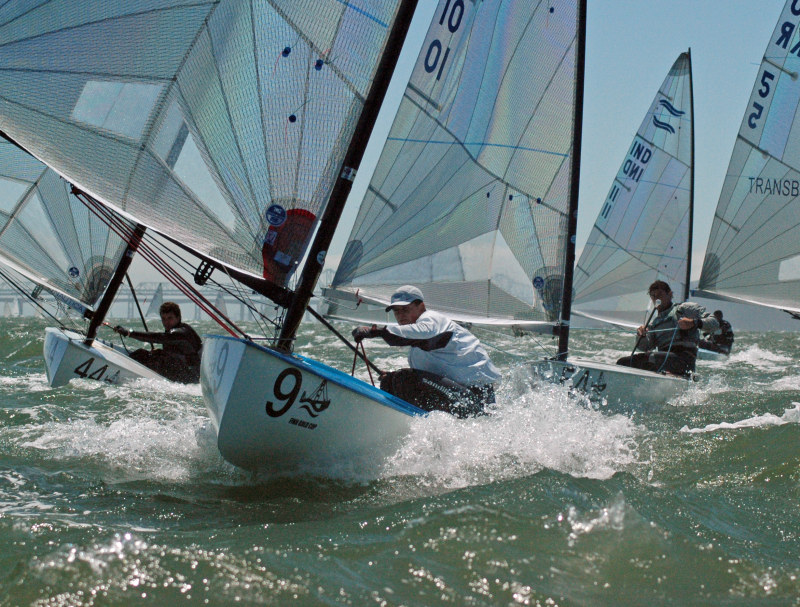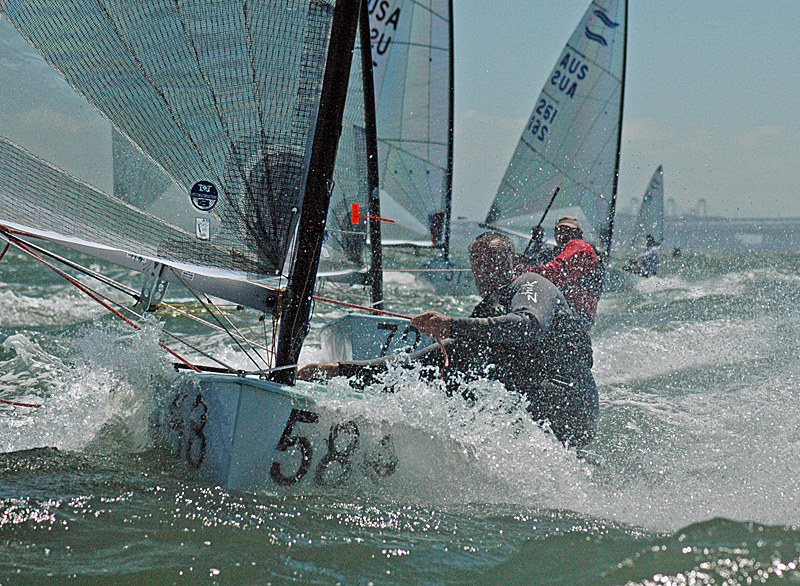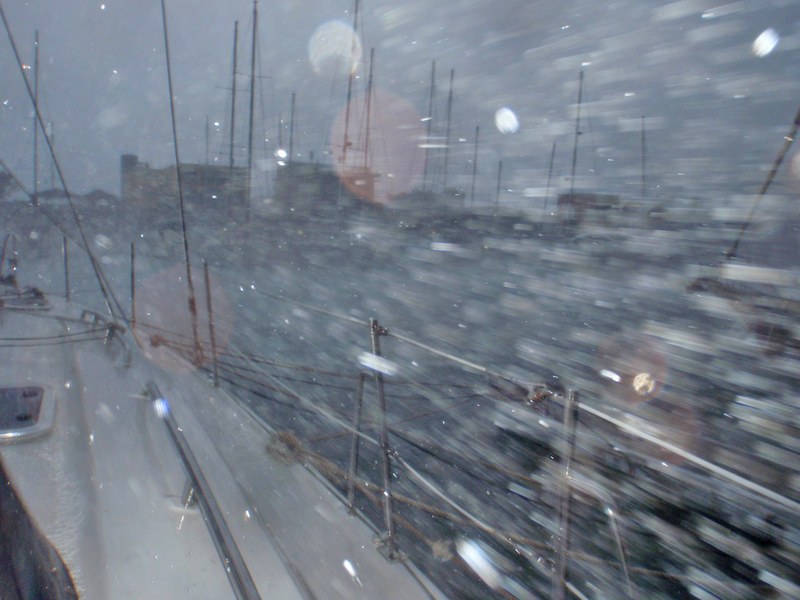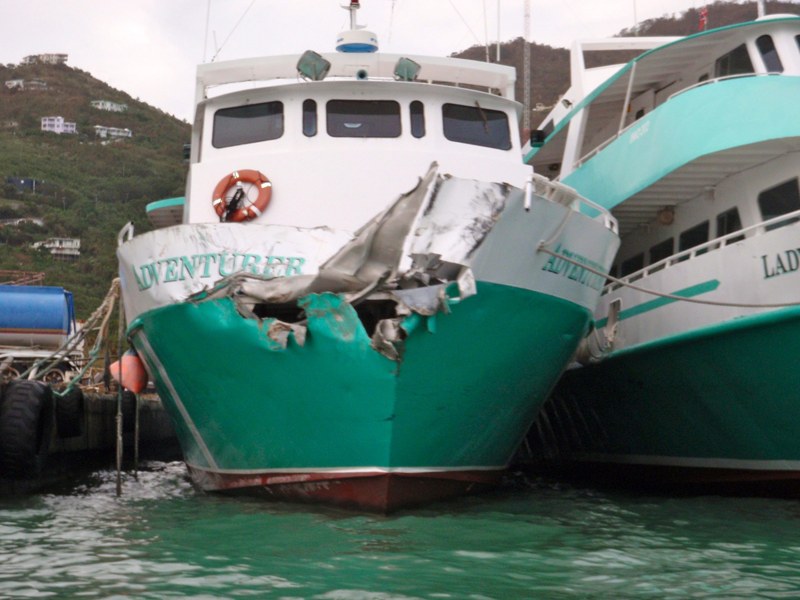
The Great San Francisco Schooner Race

Whenever ol’ salts get together, they waste no time launching into highly animated storytelling. That was certainly true in the aftermath of last Saturday’s Great San Francisco Schooner Race, as everyone had plenty of colorful anecdotes to relay. We’re just beginning to gather them for our full report in the magazine, but we can tell you from personal experience that due to sustained winds in the mid-30s, with gusts up to 40, the 18-boat fleet had a rough and rowdy trip through the Central Bay that produced tattered sails, broken gear, bruised bodies and untold amounts of adreniline coursing through the veins of the crews.

I had the privilege of sailing aboard Bill and Grace Bodle’s 115-ft (LOA) schooner Eros — the largest boat in the fleet — and if my experience is any indicator, it was a wild day of sailing for all involved that won’t soon be forgotten. After rounding the windward mark — the Blackaller buoy off Chrissy Field — the fleet blasted down the Cityfront to the St. Francis YC, broad-reaching on an incoming tide.
Just about the time that I was thinking to myself, "How the heck are we going to jibe this two-ton main boom with this much breeze?" I looked up to notice that we were freight-training on a line that would take us in-shore of a yellow buoy which lay just below the plate glass windows of the club. As we roared past it — seemingly spittin’ distance from the club’s bar — I read the marking "B" on the buoy. We were supposed to have rounded "A" which lay in safer water, about 50 yards deeper into the Bay. Hopefully we didn’t give any St. Francis patrons heart failure.

From St. Francis the fleet zig-zagged back and forth across the Central Bay, then finally back to the finish near the sponsoring club, Tiburon’s San Francisco YC. Despite all sorts of gear-related carnage, there were no major injuries — and when you’re jibing a traditional rig with running backs in 40 knots, that’s an impressive testament to the skills of these salty sailors. Look for a full report in the October edition.
Gold Cup in Full Swing

© Latitude 38 Media, LLC
Eighty-six sailors representing almost 30 countries kicked off the Finn Gold Cup Monday. With sunshine, breeze that topped out in the low-20s, and some typical Circle slop, the fleet got the weather promised in the brochure. Although there was a general recall in the first race due to the 1,800-ft starting line being too pin-favored, the second race went off on the first try. The host St. Francis YC‘s Racing Manager John Craig and PRO Kevin Reeds sent the fleet on the same course for both races — a windward/leeward, triangle, finish. The first featured 1.5-mile beats, and the second featured a nearly two-mile beat.

© Latitude 38 Media, LLC
The breeze and slop meant that the mud found 8 to 12 feet underwater off Marina Bay Yacht Harbor claimed a few of the boats’ spendy carbon rigs. Early leader Rafa Trujillo scored a 2-1 on Monday, but came back with a shocker on Tuesday, counting a 35-10 which sent him tumbling down the standings to seventh place. Briton Ed Wright knocked off two bullets yesterday, but it was France’s Thomas le Breton who breezed into the lead on the strength of an 8-7-3-3 scoreline. America’s top Finn sailor, St. Francis YC member Zach Railey, has been very consistent, scoring a 5-5-7-4 to hold down second place. The regatta continues through Saturday, and is well worth watching — if you aren’t able to make it over there, you can even watch it live on the event’s website.

© Latitude 38 Media, LLC
Bridge Collapse Isolates Nayarit Riviera
What is believed to have been "a month’s worth" of tropical rain during Mexico’s rainy season fell in one day — Monday — in the high mountains above Puerto Vallarta, resulting in the collapse, at 2:30 a.m., of a 180-foot long section of the ‘old’ or northbound bridge over the Rio Ameca just to the northwest of Puerto Vallarta and the Puerto Vallarta Airport. As a result, the two-lane northbound road between Puerto Vallarta and the ‘Nayarit Riviera’ — which includes Paradise Marina, Nuevo Vallarta Marina and the Nayarit Riviera Marina in La Cruz — was severed.

© Latitude 38 Media, LLC
This is a major problem for the entire region and the big city of Puerto Vallarta as this road/bridge was the Highway 200 lifeline for tens of thousands of people who live on one side of the bridge and work on the other. Highway 200 is also the main route for all goods and supplies from Guadalajara and the state capital of Tepic and Puerto Vallarta. Because of the collapse, the southbound bridge was also temporarily closed so it could be checked. As of today, the former southbound-only bridge is being used for two-way light vehicle traffic. It’s as though the lower deck of the Bay Bridge collapsed, and all traffic in and out of the City now has to share the upper level. It’s also being reported that two other much smaller bridges for much smaller roads upstream the Rio Ameca also collapsed.

© Latitude 38 Media, LLC
A helicopter ‘air bridge’ has been established for medical emergencies, and Vallarta Adventures is running an hourly shuttle service between Paradise Marina and Marina Vallarta, and there is other ‘ferry’ service between Marina Vallarta and La Cruz Marina. But none of these measures even begin to affect what is and will be a major problem for some time.
Something is going to have to be done very quickly. Fortunately, Mexico has a history of responding very quickly to roads being completely destroyed by hurricanes. But the rainy season doesn’t stop until the beginning of the cruising season, which is in late October, so it’s not going to be easy. Nonetheless, we’re confident they’ll have something up and running by then.
Earl in the Eastern Caribbean
While the East Coast of the United States eyes the approach of Earl, now a Category 3 hurricane, the northern islands of the Eastern Caribbean are trying to clean up the damage wrought by Earl when he came through Sunday afternoon through Monday night as anything from a Category 1 to a Category 4 hurricane — the latter meaning winds to 135 knots. Meanwhile, they are keeping an eye on Tropical Storm Fiona, which is now hitting some of them with winds to 55 knots. A poorly formed storm, Fiona will hopefully be out of everyone’s hair in a day or two.
Earl began her WNW sweep of Antigua, St. Barth and St. Martin looking to be a poorly defined Category 1 hurricane, and not that serious, in part because she would be leaving the islands to the southwest, the quadrant where the winds would be the weakest. But in short order Earl jumped to a Category 2, then 3, then 4 hurricane.

©2010 Latitude 38 Media, LLC
At least as bad, he not only developed a very tight and defined eye, but by the time he passed just to the north of the British Virgins, he was something like 200 miles across. The latter would be a critical factor, because it meant that the British and U.S. Virgins would not just get hit by hurricane force winds out of the north, northwest and west, but also trailing hurricane force winds out of the southwest and south. Road Town, the huge charterboat center of Tortola that is home to The Moorings and other charter companies, is a bay naturally protected in all directions but the south.
Even two days after Earl passed through, it has been difficult to get a good assessment of the damage to boating interests in the northern Leewards. The problem is that there are so many different islands and no common language or place to report the damage. But based on news reports and blogs, it seems certain that the damage wasn’t anywhere near as bad as it could have been. The big sailing centers of Antigua and St. Martin got hit before Earl had fully developed, and apparently did well. It’s less certain if that’s the case at St. Barths, where we’re told mariners were advised to expect just 40 knots, but then got hit by well over 100 knots.

Almost certainly the island that suffered the most was Anegada, the very low island in the northeast part of the British Virgins, and therefore probably closer to Earl‘s eye than any other. Hopefully all the boats were taken away prior to the storm, but much of the boating and other infrastructure was apparently destroyed. Our hearts go out to all the special people on that remote island.
On the brighter side, the damage at mountainous Virgin Gorda was said to be surprisingly light. For example, the big boatyard at Spanishtown reported that no boats fell over on their cradles.
The big question was always going to be what happened to Tortola, the charterboat center of the universe, and home to lots of other boats, too. Initially, things looked really good. Although the hurricane was very strong and the eye only about 70 miles away, the high island would provide a natural shield to all the boats on the south side. Indeed, things were going much better than could be expected until the winds started to come out of the west, at which point a number of boats and facilities were damaged or destroyed at Soper’s Hole in the West End. As the eye of Earl pulled away, however, the wind started coming out of the southwest and south.

© Latitude 38 Media, LLC
The following is an eye-witness report from a frequent Latitude contibutor who doesn’t want his insurance company to know he’s in the Virgins and not 400 miles away and outside of the hurricane zone in Grenada:
"I rode out Earl at the Village Cay Marina on the south side of Tortola. The two sets of wind instruments atop my 70-ft mast read a constant 74-78 knots for three hours at the worst of it, with a maximum gust of 86 knots. I had removed everything I could from the outside of my boat, and was secured by 12 strong lines and an anchor. While there were lots of downed trees and power lines, and no lights at night, my boat wasn’t damaged. In fact, there was no damage to any of the 25 other boats in the marina. However, there has been lots of damage to boats anchored out and moored out, including some large commercial vessels. The boats at The Moorings appeared to have done fine, but some sails had unfurled and some awnings at the base were damaged.
"Earl started with winds from the northwest at 45 to 48 knots, but by 10 p.m. on Monday night, the wind backed 90 degrees to the southwest and then the south. Within an hour, the wind was coming out of the south at over 70 knots, and everyone who had secured their boats for northwest winds scrambled to adjust their lines for winds from the other direction. We got our strongest wind from the south, not the north, and that caused most of the trouble to the anchored and moored boats."
It’s unclear what damage there was at Jost van Dyke, home to Foxy’s. After it was reported that the Bomba Shack on the north shore of Tortola had been destroyed, there was much grieving on the internet. Then it was reported it hadn’t been destroyed at all. Everyone was advised that the next full moon party would go on as scheduled, and that magic mushrooms are still perfectly legal in the British Virgins.

©2010 Latitude 38 Media, LLC
As for St. John and St. Thomas in the U.S. Virgins, the news seemed to be good. As with all the other islands, there were surely scattered boats that were damaged or destroyed, but not a wholesale disaster.
As previously reported, the owner of Latitude 38 has a Leopard 45 cat in a yacht management program with BVI Yacht Charters based out of Port Purcell, Road Town, on the south side of Tortola. We were initially quite confident our cat would be safe, what with her being in the weakest quardrant of the hurricane and having a high mountain between the eye of the hurricane and our boat. But after hearing nothing all day yesterday, and then learning of the surprise hurricane force winds out of the south, we began to get concerned. In the wee hours of last night we received photos of large commercial vessels stacked up at what we believed was the breakwater at Port Purcell, and we became really concerned.
We need not have. Halfway through writing this report, we spoke with a cheery Abby at the BVI base. "Oh no, everything’s fine with all our boats and with your cat," she reported in the most chipper voice possible. "In fact, ‘ti Profligate is going out on charter tomorrow."
Whew! Now if we and everybody else can just get through the rest of the hurricane season, which has suddenly gotten busy in the Atlantic/Caribbean.
September is on the Streets
‘Jonesing’ for your Latitude 38 fix? No worries. The September edition is hot off the press and on the streets today, chock full of all the latest sailing news from the Bay and beyond. If you don’t know were to find it, check out our complete distribution lists online. Happy reading!

© Latitude 38 Media, LLC
